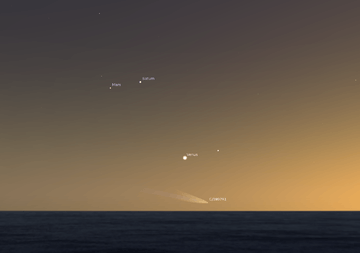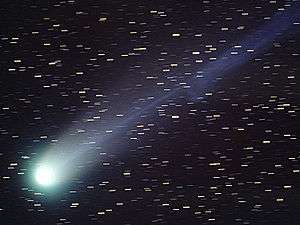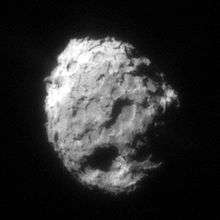C/1807 R1
| Discovery | |
|---|---|
| Discovered by | the Augustinian monk Parisi at Castrogiovanni[1] |
| Alternative designations | Great Comet of 1807 |
| Orbital characteristics A | |
| Epoch |
2381313.7389 1807-Sep-19.2389[2] |
| Aphelion | 285.8 AU[2] |
| Perihelion | 0.6461 AU[2] |
| Semi-major axis | 143.2012 AU |
| Eccentricity | 0.9955[2] |
| Orbital period | ~1714 a |
| Inclination | 63.1762°[2] |
C/1807 R1 (also known as the Great Comet of 1807) is a long-period comet, which in 1807 was visible to naked-eye observers in the northern hemisphere from early September to late December. On the basis of its outstanding brightness it is called a great comet.
Discovery and observations
Orbital data points compiled in the northern hemisphere indicate a surprising fact. This comet should have been first discovered by the unassisted eye in the southern hemisphere several weeks before its actual discovery in the northern hemisphere. However, there are no such historical reports from the southern hemisphere. In Australia the comet should have been visible during all of August in the early evening twilight on the western horizon with a brightness approaching magnitude 1.
The actual discovery is often credited to the Augustinian monk Parisi[1][3] at Castrogiovanni in Sicily, who allegedly observed the comet very close to the horizon in the early twilight of 9 September 1807, not far from the equally bright star Spica. At that particular time the planets Venus, Mars and Saturn were also near the comet.[4] Because of his favorable southerly location, Parisi at Castrogiovanni might have made his discovery several days before a number of other observers in Europe independently discovered the comet.

The surveyor Seth Pease (1764–1819)[5] saw the comet on the evening of September 20 (local time). On the following evening in Marseille Jean-Louis Pons and his colleague Jacques-Joseph Thulis (1768–1810) made the first positional determination for the comet in terms of the celestial coordinate system. In the following 10 days the comet was independently discovered by Jacques Vidal and Honoré Flaugergues in France, Edward Pigott in England, Johann Sigismund Gottfried Huth and Johann Friedrich Eule in Germany, and Gonzalez in Spain. Vidal estimated the length of the comet’s tail to be between 7° and 8° in length.
Near the end of September, on its journey away from the Sun, the comet made its closest approach to Earth. The comet was visible to the naked eye throughout the month of October. On October 1 Johann Elert Bode reported a tail length of 5°. On October 4 Huth reported that the tail had split into a straight, 6°-degree long tail and a shorter, curved tail. Both tails were also seen on October 20 when Heinrich Wilhelm Olbers noted that the two tails were separated by 1.5°; the more northerly tail was very narrow, thin and straight and about 10° long, while the more southerly tail was broad, short and about 4.5° long. A few days later, the two tails could no longer be distinguished from each other; in Natchez, Mississippi, William Dunbar saw on October 24 only a single tail, which had a length of 2.7°. In Göttingen, Johann Hieronymus Schroeter made accurate observational measurements of the comet from 4 October 1807 to 18 February 1808.[6]
In November and December the comet was still visible to the naked eye, but its brightness had steadily diminished and by the end of November the tail was difficult to discern. On November 20 William Herschel estimated the length of the tail to be 2.5°, but in the beginning of December he could identify a short tail only in large refractor.
As of January 1808 there are no reports of naked-eye observations of the comet. The last telescopic sightings of the comet wer made on February 19 by Olbers, on February 24th by Friedrich Wilhelm Bessel, and on February 28, after a long search, by Dunbar. The last telescopic observation was made by Vincent Wisniewsky in Saint Petersburg on 27 March 1808.[7]
On September 20 the comet reached a brightness between magnitude 1 and 2.[8]
Scientific importance
In October 1807 Bode, Johann Karl Burckhardt and Francis Triesnecker calculated estimates of a parabolic orbit for the comet. Initially Bessel also calculated a parabolic orbit, but additional observations enabled him to calculate an elliptic orbit. Since this estimate of an elliptic orbit still did not agree with the observations to Bessel's satisfaction, he developed a novel method for calculating the orbital elements. Bessel's method took into account the changing gravitational influences of the Sun and planets near to the comet and made better use of the observational data by means of a least squares estimation technique developed a few years earlier by Carl Friedrich Gauss.
For this comet there were observational data for over six months and thus for a significant part of the cometary orbit Bessel's calculated predictions could be compared to the observations. The great comet of 1807 is the first long-period comet (other than Halley's comet, which was already known to be periodic) for which there is empirical verification that it moves in an elliptical, and not in a parabolic, orbit.[9]
Orbit
Using observations over 187 days Bessel computed an elongated orbit inclined about 63° to the ecliptic.[2] At perihelion, which occurred on 19 September 1807 the comet was about .646 AU the Sun. The comet was on September 11 about .775 AU from Venus and on September 15 about .836 AU from Mars. On September 26 the comet made its closet approach to Earth at a distance of about 1.15 AU; for a great comet this distance is unusually large — only two other known great comets failed to come closer than 1 AU to Earth — namely, the Great Comet of 1811 and Comet Hale-Bopp.[4]
References
- 1 2 Hind, J. Russell (1852). "1807. The great comet of this year". The comets: a descriptive treatise upon those bodies. London: John W. Parker and Son. p. 154.
- 1 2 3 4 5 6 "NASA JPL Small-Body Database Browser: C/1807 R1".
- ↑ Lynn, W. T. (1902). "Edward Piggott and the Comet of 1807". The Observatory. 25 (322): 336–337. Bibcode:1902Obs....25..336L.
- 1 2 Bryant, Greg. "Bright Comets Of The Last Two Centuries - Part I".
- ↑ Encyclopedia of Cleveland History: PEASE, SETH
- ↑ J. H. Schroeter: Beobachtungen des groſsen Cometen von 1807. Göttingen 1811.
- ↑ G. W. Kronk: Cometography: A Catalog of Comets, Volume 2. 1800–1899. Cambridge University Press, 2003, ISBN 0-521-58505-8, pp. 10–14.
- ↑ Donald K. Yeomans. "NASA JPL Solar System Dynamics: Great Comets in History".
- ↑ F. W. Bessel: Untersuchungen über die scheinbare und wahre Bahn des im Jahre 1807 erschienenen grossen Kometen. Königsberg 1810.

